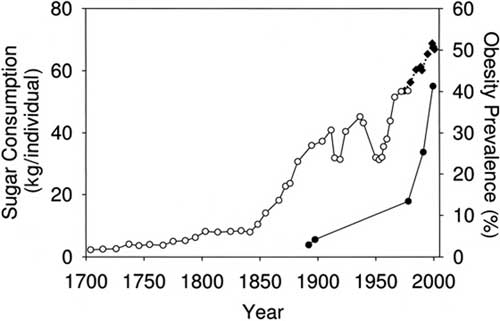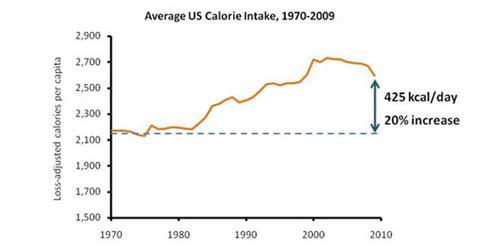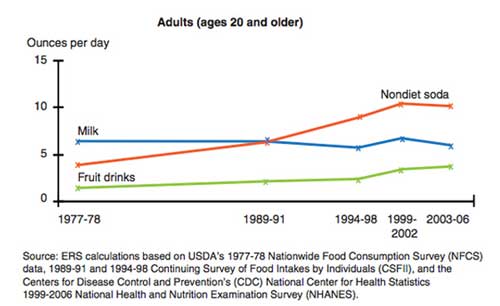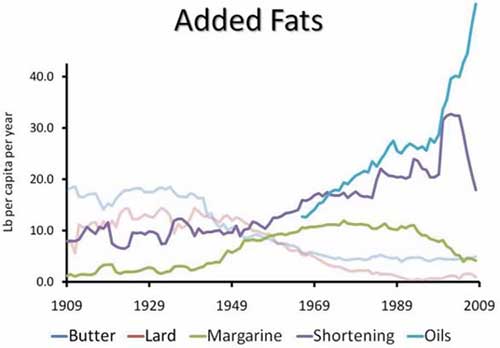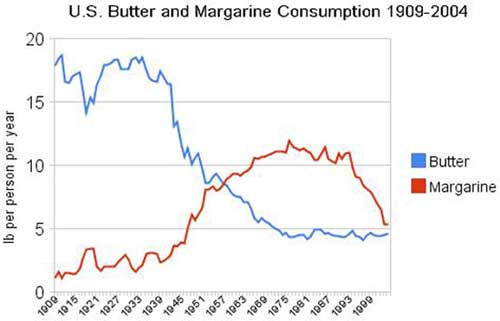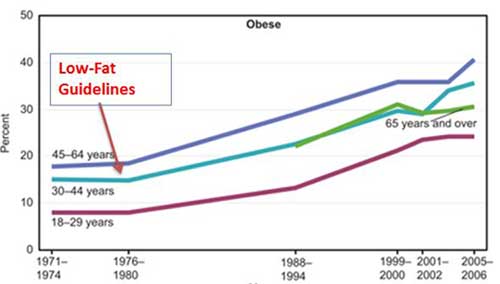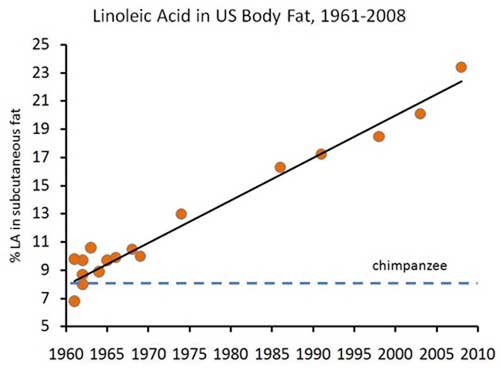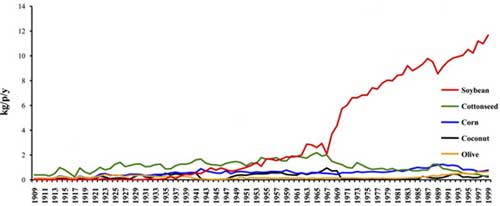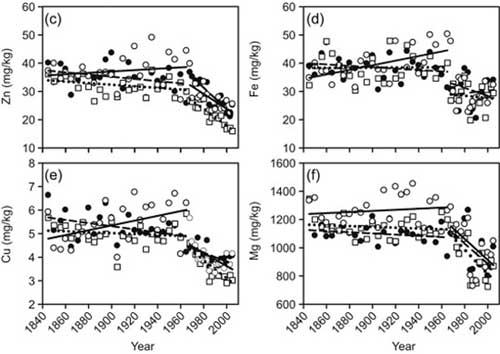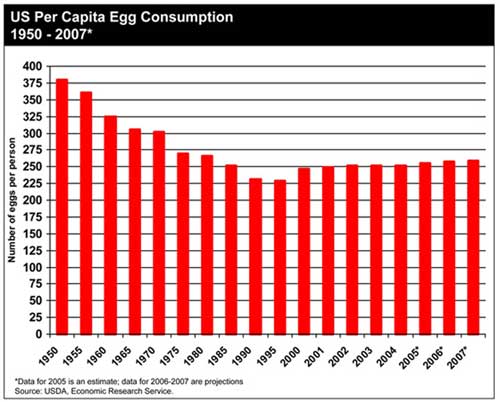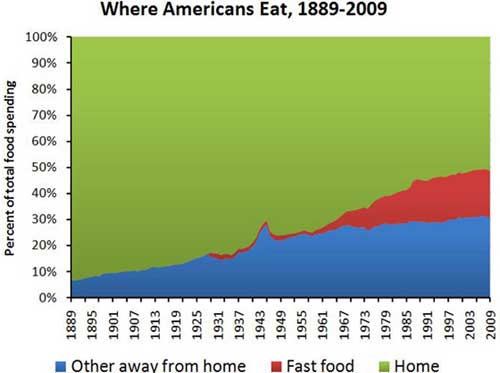By Dr. Mercola
Three decades ago, the food available was mostly fresh and grown locally. Today, the majority of foods served, whether at home, in school or in restaurants, are highly processed foods, filled with sugars, harmful processed fats, and chemical additives.
During that same time, obesity rates have skyrocketed, and one in five American deaths are now associated with obesity. Obesity-related deaths include those from type 2 diabetes, hypertension, heart disease, liver disease, cancer, dementia, and depression, as nearly all have metabolic dysfunction as a common underlying factor.
The featured1 article contains 11 telling charts and graphs, illustrating how the modern diet has led to an avalanche of chronic disease. As its author, Kris Gunnars says:
“The modern diet is the main reason why people all over the world are fatter and sicker than ever before. Everywhere modern processed foods go, chronic diseases like obesity, type 2 diabetes, and heart disease soon follow.”
Sugar Consumption, Especially Soda and Juices, Drives Disease Rates
Of all the dietary culprits out there, refined sugar in general, and processed fructose in particular, win top billing as the greatest destroyers of health. The amount of refined sugar in the modern diet has ballooned, with the average American now getting about 350 calories a day (equivalent to about 22 teaspoons of sugar and 25 percent of their daily calories) from added sugar.
This level of sugar consumption has definitive health consequences. One recent study published in the peer-reviewed journal JAMA Internal Medicine,2 which examined the associations between added sugar consumption and cardiovascular disease (CVD) deaths, found that:
- Among American adults, the mean percentage of daily calories from added sugar was 14.9 percent in 2005-2010
- Most adults (just over 71 percent) get 10 percent or more of their daily calories from added sugar
- Approximately 10 percent of American adults got 25 percent or more of their daily calories from added sugar in 2005-2010
- The most common sources of added sugar are sugar-sweetened beverages, grain-based desserts, fruit drinks, dairy desserts, and candy
According to this study, those who consume 21 percent or more of their daily calories in the form of sugar are TWICE as likely to die from heart disease compared to those who get seven percent or less or their daily calories from added sugar.
Needless to say, with all this added sugar in the diet, average calorie consumption has skyrocketed as well, having increased by about 20 percent since 1970.
A primary source of all this added sugar is soda, fruit juices, and other sweetened drinks. Multiple studies have confirmed that these kinds of beverages dramatically increase your risk of metabolic syndrome, type 2 diabetes, heart disease, and mortality. Diet sodas or artificially sweetened foods and beverages are no better, as research reveals they appear to do even MORE harm than refined sugar or high fructose corn syrup (HFCS), including causing greater weight gain.
Abandoning Traditional Fats for Processed Vegetable Oils Has Led to Declining Health
Fats help your body absorb important vitamins, including vitamins A, D, and E, and fats are especially important for infants and toddlers for proper growth and development. Moreover, when your body burns non-vegetable carbohydrates like grains and sugars, powerful adverse hormonal changes typically occur. These detrimental changes do not occur when you consume healthy fats or fibrous vegetables.
As explained by Dr. Robert Lustig, fructose in particular is “isocaloric but not isometabolic,” which means you can have the same amount of calories from fructose or glucose, fructose and protein, or fructose and fat, but the metabolic effect will be entirely different despite the identical calorie count. Furthermore, saturated fats, although supplying more calories, will NOT actually cause you to get fat, nor will it promote heart disease.
Unfortunately, the healthiest fats, including animal fats and coconut oil, both of which are saturated, have been long portrayed as a heart attack waiting to happen. Meanwhile, harmful hydrogenated vegetable oils such as corn and canola oil have been touted as “healthful” alternatives. Ditto for margarine.
Boy, did they get this wrong. Nothing could have been further from the truth. The hydrogenation process creates incredibly harmful trans fats, which the US Food and Drug Administration is now finally considering banning altogether. (I’ll review the health hazards of trans fats in further detail below.) Clearly, switching from lard and grass-fed butter—which contains heart-protective nutrients—to margarine and other trans-fat rich hydrogenated oils was a public health experiment that has not ended well.
Low-Fat Fad Has Done Unfathomable Harm
Conventional recommendations have also called for dramatically decreasing the overall amount of fat in your diet, and this fat aversion is yet another driving factor of metabolic disease and chronic ill health. As I and other nutritional experts have warned, most people (especially if you’re insulin or leptin resistant, which encompasses about 80 percent of Americans) probably need upwards of 50-85 percent of daily calories from healthful fats. This is a FAR cry from the less than 10 percent of calories from saturated fats recommended by the US Department of Agriculture.3 As stated in the featured article:
“The first dietary guidelines for Americans were published in the year 1977, almost at the exact same time the obesity epidemic started. Of course, this doesn’t prove anything (correlation does not equal causation), but it makes sense that this could be more than just a mere coincidence.
The anti-fat message essentially put the blame on saturated fat and cholesterol (harmless), while giving sugar and refined carbs (very unhealthy) a free pass. Since the guidelines were published, many massive studies have been conducted on the low-fat diet. It is no better at preventing heart disease, obesity or cancer than the standard Western diet, which is as unhealthy as a diet can get.”
There’s no telling how many have been prematurely killed by following these flawed low-fat guidelines, yet despite mounting research refuting the value of cutting out fats, such recommendations are still being pushed.
Increased Vegetable Oil Consumption Has Altered Americans’ Fatty Acid Composition
The increased consumption of processed vegetable oils has also led to a severely lopsided fatty acid composition, as these oils provide high amounts of omega-6 fats. The ideal ratio of omega-3 to omega-6 fats is 1:1, but the typical Western diet is between 1:20 and 1:50. Eating too much damaged omega-6 fat and too little omega-3 sets the stage for the very health problems you seek to avoid, including cardiovascular disease, cancer, depression and Alzheimer’s, rheumatoid arthritis, and diabetes, just to name a few. To correct this imbalance, you typically need to do two things:
- Significantly decrease omega-6 by avoiding processed foods and foods cooked at high temperatures using vegetable oils
- Increase your intake of heart-healthy animal-based omega-3 fats, such as krill oil
The Dangers of Hydrogenated Soybean Oil
About 95 percent of soy is genetically engineered to have resistance to glyphosate and is loaded with this highly toxic herbicide. But even if you have organic soy, most of it is hydrogenated. Hydrogenated soybean oil has, like sugar, become a major source of calories in the US diet. Americans consume more than 28 billion pounds of edible oils annually, and soybean oil accounts for about 65 percent of it. About half of it is hydrogenated, as soybean oil is too unstable otherwise to be used in food manufacturing. In 1999, soybean oil accounted for seven percent of consumed daily calories in the US.
Part of the problem with partially hydrogenated soybean oil is the trans fat it contains. The other part relates to the health hazards of soy itself. An added hazard factor is the fact that the majority of soybeans are genetically engineered. The completely unnatural fats created through the partial hydrogenation process cause dysfunction and chaos in your body on a cellular level, and studies have linked trans-fats to:
Cancer, by interfering with enzymes your body uses to fight cancer Chronic health problems such as obesity, asthma, auto-immune disease, cancer, and bone degeneration Diabetes, by interfering with the insulin receptors in your cell membranes Heart disease, by clogging your arteries (Among women with underlying coronary heart disease, eating trans-fats increased the risk of sudden cardiac arrest three-fold!) Decreased immune function, by reducing your immune response Increase blood levels of low density lipoprotein (LDL), or “bad” cholesterol, while lowering levels of high density lipoprotein (HDL), or “good” cholesterol Reproductive problems, by interfering with enzymes needed to produce sex hormones Interfering with your body’s use of beneficial omega-3 fats
Besides the health hazards related to the trans fats, soybean oil is, in and of itself, NOT a healthy oil. Add to that the fact that the majority of soybeans grown in the US are genetically engineered, which may have additional health consequences. When taken together, partially hydrogenated GE soybean oil becomes one of the absolute worst types of oils you can consume. Unfortunately, as stated in the featured article:4
“[M]ost people don’t have a clue they’re eating this much soybean oil. They’re actually getting most of it from processed foods, which often have soybean oil added to them because it is cheap. The best way to avoid soybean oil (and other nasty ingredients) is to avoid processed foods.”
Wheat – A Bane of the Modern Diet
Modern wheat is not the same kind of wheat your grandparents ate. The nutritional content of this staple grain has been dramatically altered over the years and is now far less nutritious than the varieties of generations past. As Gunnars states:5
“Modern dwarf wheat was introduced around the year 1960, which contains 19-28 percent less of important minerals like Magnesium, Iron, Zinc, and Copper. There is also evidence that modern wheat is much more harmful to celiac patients and people with gluten sensitivity, compared to older breeds like Einkorn wheat. Whereas wheat may have been relatively healthy back in the day, the same is not true of modern dwarf wheat.”
Wheat lectin, or “wheat germ agglutinin” (WGA), is largely responsible for many of wheat’s pervasive ill effects. WGA is highest in whole wheat, especially sprouted whole wheat, but wheat isn’t the only grain with significant lectin. All seeds of the grass family (rice, wheat, spelt, rye, etc.) are high in lectins. WGA has the potential to damage your health by the following mechanisms (list is not all-inclusive):
Pro-Inflammatory: WGA lectin stimulates the synthesis of pro-inflammatory chemical messengers, even at very small concentrations Neurotoxic: WGA lectin can pass through your blood-brain barrier and attach to the protective coating on your nerves, known as the myelin sheath. It is also capable of inhibiting nerve growth factor, which is important for the growth, maintenance, and survival of certain neurons Immunotoxic: WGA lectin may bind to and activate white blood cells Cardiotoxic: WGA lectin induces platelet aggregation and has a potent disruptive effect on tissue regeneration and removal of neutrophils from your blood vessels Cytotoxic (toxic to cells): WGA lectin may induce programmed cell death (apoptosis) Research also shows that WGA maydisrupt endocrine and gastrointestinal function, interfere with genetic expression, and share similarities with certain viruses
Flawed Assumptions About Eggs Have Worsened Health
According to USDA data, Americans ate more than 375 eggs per person per year, on average, in 1950. Egg consumption dipped to just over 225 eggs per capita between 1995 and 2000, and as of 2007, it was just over 250 eggs per capita per year—a 33 percent decline since 1950.
Like saturated fats, many naturally cholesterol-rich foods have also been wrongfully vilified. Eggs, which are actually among the most nutritious foods you can eat (provided they come from organically raised, pastured hens) have long been accused of causing heart disease simply because they’re high in cholesterol. But dietary cholesterol has little to do with the cholesterol level in your body, and numerous studies have confirmed that eating eggs does NOT raise potentially adverse LDL cholesterol in your blood. Studies have also failed to find any evidence that eggs contribute to heart disease.
Testing6 has confirmed that true free-range eggs are far more nutritious than commercially raised eggs. The dramatically superior nutrient levels are most likely the result of the differences in diet between free-ranging, pastured hens and commercially farmed hens. In a 2007 egg-testing project, Mother Earth News compared the official U.S. Department of Agriculture (USDA) nutrient data for commercial eggs with eggs from hens raised on pasture, and found that the latter typically contains:
- 2/3 more vitamin A
- Two times more omega-3 fatty acids
- Three times more vitamin E
- Seven times more beta-carotene
Barring organic certification, which is cost-prohibitive for many small farmers, you could just make sure the farmer raises his chickens according to organic, free-range standards, allowing his flock to forage freely for their natural diet, and aren’t fed antibiotics, corn, and soy.
You can tell the eggs are free range or pastured by the color of the egg yolk. Foraged hens produce eggs with bright orange yolks. Dull, pale yellow yolks are a sure sign you’re getting eggs from caged hens that are not allowed to forage for their natural diet. Cornucopia.org offers a helpful organic egg scorecard that rates egg manufacturers based on 22 criteria that are important for organic consumers. According to Cornucopia, their report “showcases ethical family farms, and their brands, and exposes factory farm producers and brands in grocery store coolers that threaten to take over organic livestock agriculture.”
People Eat More Processed Food Than Ever Before
Overall, about 90 percent of the money Americans spend on food is spent on processed foods.7 This includes restaurant foods (i.e. food away from home) and processed grocery foods that require little or no preparation time before consuming at home.
When looking at the ratio of money spent on store-bought groceries only, Americans spend nearly a fourth of their grocery money on processed foods and sweets—twice as much as they did in 1982—according to Department of Labor statistics.8 Pricing of meats, sugar, and flour has had a great influence our spending habits. These items have actually seen a decrease in price per pound, which has had an inverse effect on Americans’ spending habits, in that cheaper prices encourage people to buy more.
The result is obvious. Compared with shoppers 30 years ago, American adults today are twice as likely to be obese, and children and adolescent three times as likely to be overweight. Pediatric type 2 diabetes—which used to be very rare—has markedly increased along with the rise in early childhood obesity. According to previous research, early onset type 2 diabetes appears to be a more aggressive disease from a cardiovascular standpoint.9
Take Control of Your Health
Research coming out of some of America’s most respected institutions now confirms that sugar is a primary dietary factor driving chronic disease development. Sugar, and fructose in particular, has been implicated as a culprit in the development of both heart disease and cancer, and having this information puts you in the driver’s seat when it comes to prevention. A diet that promotes health is high in healthful fats and very, very low in sugar and non-vegetable carbohydrates.
Understand that excessive sugar/fructose consumption leads to insulin resistance, and insulin resistance appears to be the root of many if not most chronic disease. So far, scientific studies have linked excessive fructose consumption to about 78 different diseases and health problems,10 including heart disease and cancer.
Many also eat far too little healthy fat, and the combination of too much sugar and too little fat is driving disease rates through the roof. If you’re still unsure about what constitutes a healthy diet, please review my free optimized nutrition plan, which starts at the beginner level and goes all the way up to advanced.
My book “Dentistry and how it’s damaging your health” is available here for only $2.99
